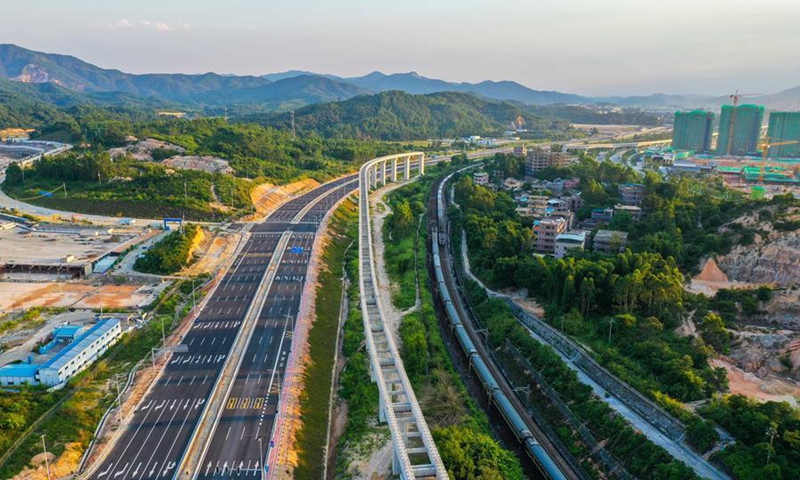China to build smart railway network by 2035 using 5G, BeiDou Navigation Satellite System
Source: Global Times Published: 2020/8/13 12:52:55

Aerial photo taken on Aug. 9, 2020 shows a medium-low-speed maglev railway under construction near Chimelong theme park in Qingyuan City, south China's Guangdong Province. The main project of the Qingyuan maglev tour line is expected to be completed at the end of this year. (Xinhua/Liu Dawei)
China State Railway Group, or China Railway, has issued an outline of its railway plan which sets out development goals and major tasks to be achieved by 2035 and 2050, including a national railway network exceeding 200,000 kilometers and a smart railway using 5G technology and the BeiDou Navigation Satellite System (BDS).
According to a report China Railway sent to the Global Times on Thursday, BDS and 5G technology will be used to form an integrated train control system using data collected from both land and space.
With the new technologies, the train control system will have more accurate positioning, guarantee stronger security, shorten the train tracking interval, and improve transport capacity by more than 30 percent.
If the new train control system is adopted, a round trip on the Beijing-Shanghai high-speed railway could save about 9,000 kilowatt-hours of electricity.
"The plan released by China Railway emphasizes intelligence, environmental-friendly design and efficiency, which can be seen as digital upgrading, the core of the construction of the next-generation logistics network," Chen Bo, an associate research fellow at the Institute for Finance and Economics under the Central University of Finance and Economics, told the Global Times on Thursday.
Railways are traditional infrastructure and are not included in China's current infrastructure catalog, but the digital upgrading of traditional infrastructure will gradually be included in new infrastructure construction plan, Chen noted.
By 2035, China will take the lead as a modern railway power with safe and high-quality services, strong security and world-leading strength, according to China Railway.
It said China will build a railway network of more than 200,000 kilometers by the end of 2035, including about 70,000 kilometers of high-speed tracks. Railways will be extended to cities with population of 200,000 or more, and high-speed rail will cover cities with population of over 500,000.
China Railway also vowed to make railway technologies self-sufficient by improving the independent innovation capacity and modernization of the railway industry chain. The construction of smart high-speed railways will be completed first, followed by smart railways.
China's fixed asset investment to GDP ratio has been declining year by year since 2015, indicating that the economic dividend of traditional infrastructure is slowly diminishing. New infrastructure construction will help improve the operational efficiency of traditional infrastructure, carry out digital upgrading, and also issue related new infrastructure bonds, said Chen.
China's operational railway length reached 141,400 kilometers by the end of July, ranking second in the world. The length of high-speed railways was 36,000 kilometers, ranking first in the world, per data from China Railway.
In July, China's railway cargo shipments continued to grow, reaching 320 million tons, up 24.66 million tons or 8.5 percent year-on-year.
In 2019, railway passengers transported reached 3.66 billion, and freight transport topped 4.32 billion tons.
High-speed railway related stocks opened higher on Thursday. Shares of China High-Speed Railway Technology Co once surged 5.16 percent during morning trading session.
Posted in: INDUSTRIES,BIZ FOCUS